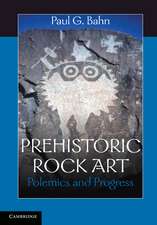The Emergence of Pressure Blade Making: From Origin to Modern Experimentation
Editat de Pierre M. Desrosiersen Limba Engleză Paperback – 13 apr 2014
Recent research on pressure knapping has led for the first time to a global thesis on this technique. The contributors to this seminal work combine research findings on pressure knapping from different cultures around the globe to develope a cohesive theory. This contributions to this volume represents a significant development to research on pressure knapping, as well as the field of lithic studies in general.
This work will be an important reference for anyone studying the Paleolithic, Mesolithic, and Neolithic periods, lithic studies, technologies, and more generally, cultural transmission.
| Toate formatele și edițiile | Preț | Express |
|---|---|---|
| Paperback (1) | 652.64 lei 6-8 săpt. | |
| Springer – 13 apr 2014 | 652.64 lei 6-8 săpt. | |
| Hardback (1) | 659.20 lei 6-8 săpt. | |
| Springer – 13 mar 2012 | 659.20 lei 6-8 săpt. |
Preț: 652.64 lei
Preț vechi: 767.81 lei
-15% Nou
Puncte Express: 979
Preț estimativ în valută:
124.90€ • 129.91$ • 103.11£
124.90€ • 129.91$ • 103.11£
Carte tipărită la comandă
Livrare economică 15-29 aprilie
Preluare comenzi: 021 569.72.76
Specificații
ISBN-13: 9781489991102
ISBN-10: 1489991107
Pagini: 548
Ilustrații: XII, 536 p.
Dimensiuni: 155 x 235 x 29 mm
Greutate: 0.76 kg
Ediția:2012
Editura: Springer
Colecția Springer
Locul publicării:New York, NY, United States
ISBN-10: 1489991107
Pagini: 548
Ilustrații: XII, 536 p.
Dimensiuni: 155 x 235 x 29 mm
Greutate: 0.76 kg
Ediția:2012
Editura: Springer
Colecția Springer
Locul publicării:New York, NY, United States
Public țintă
ResearchCuprins
Part 1: History of Research on Pressure Knapping.- Part 2: Pressure Knapping in the World.- Africa.- Europe.- Asia and the Arctic World.- Mesoamerica.- Part 3: Recent Advances in Experimentation.
Recenzii
“This volume should be commended for its successful and holistic effort in highlighting phenomena associated with pressure blade production through experimental, archaeological and historical investigations. This almost Herculean effort is clear, concise and marks a milestone in studies of blade technology. It is quintessential for anyone interested in studies of pressure blade production.” (Christian Steven Hoggard, Journal of Lithic Studies, Vol. 2, 2015)
"The Desrosiers volume leans more strongly towards the Continental tradition, and in typical chaîne opératoire fashion relies on empirical data to inform on lithic connaissances (knowledge) and savoir-faires (knowhow) to trace the culture historical progress of pressure blade flaking...Desrosiers provides an ideal opportunity to widen the investigative lens by considering technological approaches holistically." (Sarah Wurz, South African Archaeological Bulletin, Vol 199, 2014)
"The Desrosiers volume leans more strongly towards the Continental tradition, and in typical chaîne opératoire fashion relies on empirical data to inform on lithic connaissances (knowledge) and savoir-faires (knowhow) to trace the culture historical progress of pressure blade flaking...Desrosiers provides an ideal opportunity to widen the investigative lens by considering technological approaches holistically." (Sarah Wurz, South African Archaeological Bulletin, Vol 199, 2014)
Textul de pe ultima copertă
The evolution of humanity has been a long and steady process in which stone tool technology played a prominent role for the bulk of human history. Through advancements in lithic technology, humans were able to adapt to different climates, colonize new territories, and produce new inventions. One important breakthrough occurred with the adoption of pressure blade production, which in some places was closely followed by the beginning of the Neolithic way of life and the development of state societies. It may prove to have been a significant step towards the emergence of more complex societies. It was also a valuable acquisition in hunter-gatherer societies, some of which then proceeded to subsist in previously uninhabited environments such as the High Arctic. The advent of pressure blade production undoubtedly constituted a considerable improvement in stone tool technology, and as such formed a major step in the evolution of human kind.
Research on pressure blade making has intensified to the point where we are now able to compile a global overview on the use of this technique, presented for the first time in this volume. The research assembled here covers the origins, development and eventual abandonment of this technology within a variety of geographical and temporal contexts. This seminal effort presents research into past cultures from around the globe, resulting in a comprehensive portrait of pressure blade production.
This work will be an important reference for anyone studying lithic technology and experimental archaeology, or those interested in the Paleolithic, Mesolithic, and Neolithic periods, as well as the colonization of the New World. More generally, it is of interest to anyone who wants to garner an understanding of the mechanisms of cultural transmission through time and space.
Research on pressure blade making has intensified to the point where we are now able to compile a global overview on the use of this technique, presented for the first time in this volume. The research assembled here covers the origins, development and eventual abandonment of this technology within a variety of geographical and temporal contexts. This seminal effort presents research into past cultures from around the globe, resulting in a comprehensive portrait of pressure blade production.
This work will be an important reference for anyone studying lithic technology and experimental archaeology, or those interested in the Paleolithic, Mesolithic, and Neolithic periods, as well as the colonization of the New World. More generally, it is of interest to anyone who wants to garner an understanding of the mechanisms of cultural transmission through time and space.
Caracteristici
First book to provide a comprehesive, synthesized thesis on pressure knapping Comprehensive research from around the world, through different cultural and historical periods Updates the current research on pressure knapping, offering new perspectives from experts in the field













